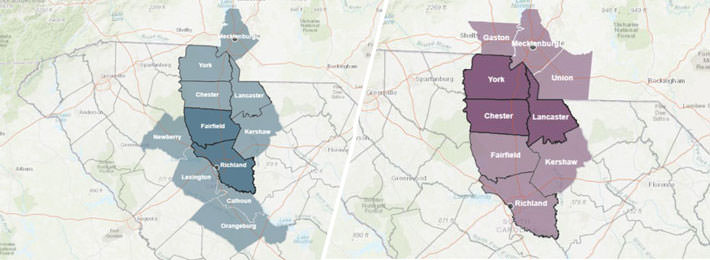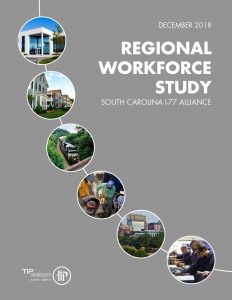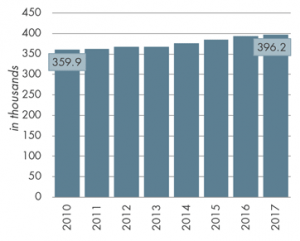The South Carolina I-77 Alliance is excited to announce the release of our new regional workforce study, a broad, in-depth look at the labor pool and demographic advantages available to companies considering initial or expanded investment in the five-county corridor between Columbia and Charlotte.
The study —Regional Workforce Study for the SC I-77 Alliance — analyzes workforce data vital to site selection, including job-skills, commuting patterns, occupational structure, wages, worker demographics, and much more. In addition to the regional analysis, summaries were also created for our individual counties: Chester, Fairfield, Lancaster, Richland, and York. It also serves as an invaluable companion to our comprehensive Economic Data Center.
As with our first workforce study in 2017, TIP Strategies Inc. of Austin, TX was retained to conduct the research and interviews for this robust report. Working with third-party partners is important, as they bring objectivity, an outside perspective, and special expertise to the process.
The study itself reaffirmed the need for this update during a time of intense competition for qualified employees, as it details a region experiencing rapid growth, with advancements in training and work-readiness. Additionally, this latest version reflects the addition of Lancaster County to the Alliance region.
Data is knowledge and knowledge is power. Our new workforce study provides quantifiable, compelling proof of the corridor’s attractiveness to industrial recruitment.
Here are some highlights from the report:
Healthy Population Growth

The five-county region has experienced healthy population growth for the past 10 years — especially York and Lancaster counties — and is actually a net importer of labor, with 151,853 workers commuting into the corridor for work and 131,426 commuting to jobs outside the corridor.
Growth of the Civilian Labor Force
The civilian labor force in the five-county corridor grew from 359,000 to 396,200 from 2010 through 2017. That 10% increase is significantly higher than the South Carolina rate (7.3%) and the national rate (4.2%).
Two Growing Labor Sheds

Operations locating or expanding anywhere in the I-77 region will have access to one of two labor sheds, each with a civilian labor force exceeding 1.2 million people, supported by the rapidly growing Charlotte, NC, and Columbia, SC, regions.
Educated Workforce
46% of the production and maintenance workers in the labor shed have post-secondary credentials or degrees, compared to the national average of 43%.
Lower Average Hourly Wage
The regional median hourly wage for almost all major occupational groups in the Corridor is at, or below the U.S. median.
Site selectors and companies want to identify markets with a young, dynamic workforce; however, data and analysis can’t represent the full picture. In addition to this quantitative research, TIP Strategies hosted roundtable sessions with local employers to discuss their experiences with the labor force and its strengths and weakness. These interviews provided a personal, qualitative dimension to their findings and analysis.
We’re pleased to present the new report; confident it contains the best data available for our region to successfully compete in the global economy for operations with the highest workforce standards.




